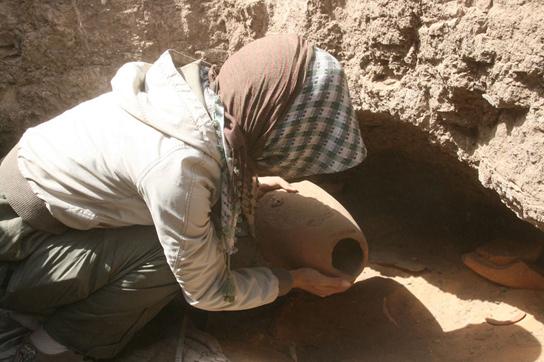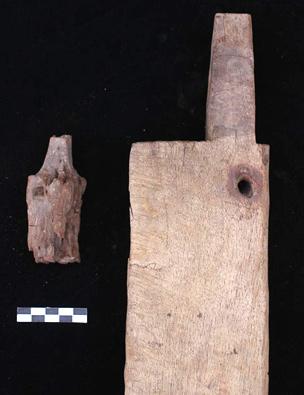Amara West 2012: changing funerary practises
Michaela Binder, Durham University
Source - http://blog.britishmuseum.org/
Up in Cemetery D at Amara West it’s getting increasingly busy as we look towards the last week of excavation. For the last few days I’ve been working with Laurel Engbring on G314 – which has turned out to be one of the most important discoveries this year, with two burial chambers underneath a tumulus superstructure.

Laurel recovering a large vessel from the western chamber in G314
The large amount of schist slabs covering and blocking the narrow shaft may have prevented the thorough looting (ancient and modern) we often encounter in Cemetery D. Therefore, both chambers provide us with a glimpse into burial customs and cultural expression in the time period after the Egyptian occupation of Amara West, from around 1000 BC onwards. Preservation of organic materials and human remains is also excellent in this grave.
n the western chamber we have revealed one wooden burial bed, and there may be one beneath it. Seven individuals were buried in this small chamber (five metres-square), including adults and children – lying over each other in a rather confusing manner.
The burial positions changed over the period during which the grave was used: the uppermost were buried in a Nubian manner, tightly flexed, whereas the bodies underneath were buried in an extended position, typical of burials in Egypt. A third extended burial has just been found in the entrance area to the western chamber.

3,000 years of bed-making – ancient fragment from G314 (left), modern example (right).
What the motivations were for laying out the bodies in this way is difficult to say.
The pottery assemblage from this tomb includes vessel types so far unknown at Amara West, suggesting the development of a local tradition in which Egyptian vessel forms were taken and modified to suit local tastes.
And of course there’s plenty of interesting details for the physical anthropologist. Just yesterday, Laurel recovered an individual with a healed fracture of the sacrum (a large bone at the base of the spine) and a lumbar vertebrae – indications of what must have been an incredibly painful fall on the individual’s backside…